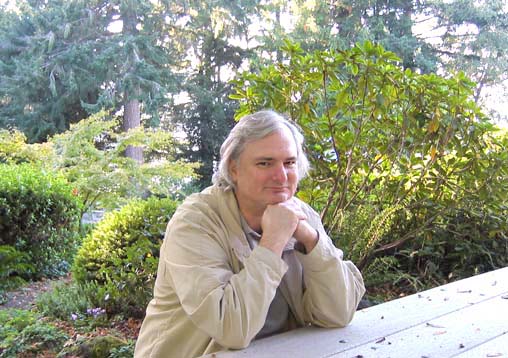
Relaxing on a beautiful fall day at Scenic Beach State Park
Photo by Karna Olson
Welcome to the Soul of Sound page! The story opens in 1975 with Audionics setting aside the Shadow Vector Quadraphonic Decoder project and drafting me into speaker design. Their in-house speaker guru had left town without warning, leaving no forwarding address or phone number, and your author (Lynn Olson) had to shift from idle curiosity to get-it-done-or-else reality. Not the easiest speaker to start with, either: a five-foot-high four-driver monster transmission line. Worse, the enclosure and the drivers were already pre-selected: the KEF T27 (not great), KEF B110 (worse), Richard Allen 8" (quite nice), and the KEF B139 (very very troublesome). These drivers, although famous in many mid-Seventies systems, were inefficient (85 dB/metre) and very rough in the response curves, with 6-8 dB deviations. So the crossovers have to be very complex if the speaker wasn't going to unbearably colored (for example, the BBC LS3/5a has a 6 dB notch filter right in the midband of the B110).
Six months later, with the aid of a Hewlett-Packard 1/3 octave real-time analyzer and a 1/2" condenser mike, I had something we could sell. We called it the Audionics TL-M200 and sold maybe 8 pairs total ... understandable considering the high price and uneven performance. The speakers that followed it, the TL-30c, M-32, M-33, T-52, LO-2, and maybe some others, were considerably more successful, and by then I had picked up elements of KEF's target-filter design theory and Theile/Small measurement and modelling techniques. Audionics recruited me for writing advertising copy, which was a lot more fun than designing speakers, and best of all, led to my next job in 1979 as a technical writer for Tektronix, which paid about triple what Audionics paid ... best of all, the paychecks didn't bounce. (An important consideration after working in the high-end biz for several years.)
After nine years in Tektronix, I was swept up in the Third Big Layoff of 1988, and moved into computer network design, which turned out to be the Next Big Thing with the Arpanet of the Eighties evolving into the Internet of the Nineties. I didn't find computers all that thrilling, which is probably why I'm not a billionaire, but in 1991 I started writing for a little audio-club magazine called Positive Feedback. When David Robinson took over editorship of the Oregon Triode Society's little four-pager, he grew it into a national magazine, and articles I had written to entertain the Portland locals were now showing up in Hong Kong and Paris.
The SE-DHT excitement started to warm up in Portland in 1992, and many of my audio-friends asked me to design a triode-friendly speaker. I had just bought a PC-based MLSSA system a year earlier, so it was hard to turn down. Thus began the first version of the Ariel, which appeared in Positive Feedback magazine in the spring of 1993.
Over time, more and more people kept asking for magazine reprints; I was using the primitive Mosaic 1.1 Web browser at home and at work, and I realized I could save a lot of time and hassle by converting the magazine article to HTML and publish it on the Web. Well, I don't know if I really saved all that much time or not, but that's where the website you're now reading started, in 1994-95 at the dawn of the Web.
I've written for the Audio Engineering Society Journal (my first article, in 1979), Positive Feedback, Glass Audio, Valve & Tube News, and Vacuum Tube Valley, as well as various Internet forums. Here's a sample of the more interesting articles, along with the original Shadow Vector patent and essays by my favorite authors.

| |

| |

| |

| |

| |

| |

| |

| |

| |

| |

| |

| |

| |

|
|

|
|

|
|
| The invention that started my career in high-end audio, the Shadow Vector Quadraphonic Decoder, an early (1975) dynamic-matrix decoder for the CBS SQ matrix and a predecessor of the Dolby Pro Logic II decoders used in cinemas and home theater systems today. Cited twice by subsequent Yamaha patents and three times by subsequent Dolby Labs patents. | |

|
|
| A slightly ahead-of-its-time idea I had while working at Tektronix. Cited by 108 other patents. Nearly twenty years later, 3D mice seem to have found a home in some niche markets, like presentations and home theatre PC interfaces. This patent is a good example of what happens when you arrive on a market too early. | |

|
Gray-Scale Digital Display Patent #4,890,237 (544K PDF, 6 pages) |
| Primary inventor Bob Bales of Tektronix, with some ideas of my own. This was an early (mid-Eighties) system for assigning brightness values to a digital-storage display, with the digital trace getting brighter the more times the trace passed over the same pixel; this mimics the action of a traditional direct-view analog oscilloscope or spectrum analyzer, with the additional benefit of user-adjustable variable persistence. Cited by five other patents, including ones assigned to Tektronix and Hewlett-Packard. | |

|
Getting the most out of Vacuum Tubes (12.5MB PDF, 164 pages) |
| Written in 1960 by Robert B. Tomer, a CBS Electronics engineer, and an essential resource for all engineers and designers working with vacuum tubes today. I'd like to thank John Atwood of One Electron for the scan of this rare and long out-of-print book. |